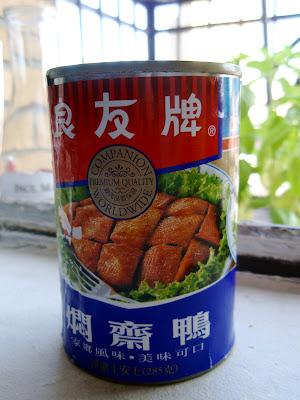
Some people seem to want their food to deceive them. Maybe it started with I Can’t Believe It’s Not Butter, but it’s the vegetarian crowd that has really taken off with the idea. It’s easy enough to be a vegetarian in a city like New York – most restaurants have meatless options on the menu – but certain establishments and food manufacturers have ensured that one can give up meat without giving up, for example, barbeque chicken wings, pork buns, and roast beef sandwiches (for vegetarians craving any of these items, check out Red Bamboo). I’ve had some tasty dishes with marinated tofu, baked seitan, and all kinds of other glutinous protein products, but I’ve never seen the need to convince myself that they were former animal parts. Still, curiosity compelled me to add a can of “duck” to my basket of exciting finds at Hong Kong Supermarket in Sunset Park.
The other thing that makes me resist meatless meat is the quirky naming conventions. “Faux chicken” sounds less than appetizing, “krab” gets lost amongst other typos, and the oxymoronic “vegetarian tuna salad” just gives the impression that the chef was confused. For duck, following the template of the infamous “tofurkey” is dangerous. I’ve heard “mock duck” is fairly common, but the label on the can I bought is entirely in Chinese, so I think I can call it whatever I want.
I was actually pretty excited about this duck stuff. As it sat in my cupboard, I began to think that this 89-cent can might provide an ingenious way to eat duck, or something sufficiently duck-like, a couple times a week. Then, I opened the can. It smelled like cat food. It smelled a lot like cat food.

But I persevered. I fished a few hunks of rubbery brown protein out of the liquid, and observed the careful imprinting on some of the pieces, meant to mimic the texture of duck skin. I assembled some things that had a better chance of tasting good: broccoli, soy sauce, and a blend of zatar and five-spice powder, which I threw into a bowl with the “duck” and, uh, put in the microwave for a minute (I wasn’t about to devote a lengthy cooking process to such a risky ingredient). I retrieved the steaming mixture, topped it with chopped fresh basil and some hot sesame oil, and added some leftover jicama that had been marinating in lime juice and chili powder.

Fake duck may also taste like cat food. It may not. I’ve never had cat food. But truthfully, it doesn’t taste that bad. It’s pretty salty, and probably could have used a little less soy sauce. It’s reminiscent of meat, in the way that George Clooney is reminiscent of Cary Grant – and George Clooney has been in some good things over the years. Soy gluten, or whatever this stuff is made of, is a good way to add some satisfying chewiness to a bowl of vegetables, and it probably provides a good dose of protein too. I can’t say the textured outer layer does anything to make it particularly like duck, and the taste wasn’t identifiably duck-like either; but then again, I haven’t had duck in a while. I guess I'll have to splurge on a nice piece of duck breast after all, to make a fair comparison.


No comments:
Post a Comment